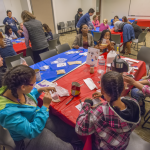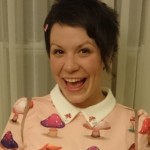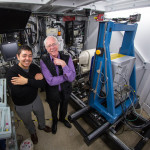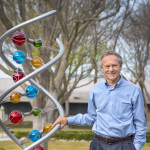 Women’s History Month is an annual declared month, celebrated in March that highlights the contributions of women to events in history and contemporary society. The 2016 theme honors women who have shaped America’s history and its future through their public service and government leadership. LBL’s Biosciences Emery Station Operations Center (ESOC) is celebrating the occasion with a number of activities for its staff and local students.
Women’s History Month is an annual declared month, celebrated in March that highlights the contributions of women to events in history and contemporary society. The 2016 theme honors women who have shaped America’s history and its future through their public service and government leadership. LBL’s Biosciences Emery Station Operations Center (ESOC) is celebrating the occasion with a number of activities for its staff and local students.
JBEI’s Inventory of Composable Elements (ICE) Tutorial Now Available
The public can learn how to use this free DNA/strains/seeds repository
 JBEI’s Inventory of Composable Elements (ICE) is a cloud-based freely open-source DNA part, plasmid, microbial strain, and Arabidopsis seed repository with physical sample tracking capabilities. It includes features such as DNA sequence editing and annotation, auto-aligning sequencing trace files against reference templates, SBOL XML/RDF support, and web-of-registries functionality. An ICE tutorial by Nathan Hillson, JBEI’s Director of Synthetic Biology Informatics is now available online. Read more on the JBEI website.
JBEI’s Inventory of Composable Elements (ICE) is a cloud-based freely open-source DNA part, plasmid, microbial strain, and Arabidopsis seed repository with physical sample tracking capabilities. It includes features such as DNA sequence editing and annotation, auto-aligning sequencing trace files against reference templates, SBOL XML/RDF support, and web-of-registries functionality. An ICE tutorial by Nathan Hillson, JBEI’s Director of Synthetic Biology Informatics is now available online. Read more on the JBEI website.
Celebrating Biosciences Women in Science and Public Service
March is Women’s History Month, a time to recognize and celebrate the diverse and historic accomplishments of women. The theme for 2016 is to honor women who have shaped America’s history and its future through their public service and government leadership. In honor or Women’s History Month Berkeley Lab has profiled Facilities Division Director Reva Nickelson, as well as two Biosciences women, Shiela Dixson and Lauren Lui:
Shiela Dixson, a financial analyst matrixed to the Biosciences University/Hill Operations, who left the Lab March 15 for a new position at Livermore, talks about achieving her life goals of obtaining her MBA and creating a nonprofit for mentoring underprivileged girls.
Lauren Lui, a postdoctoral fellow in Adam Arkin’s bioengineering lab, has been at the Lab for only 5 months but has already taken on the role of secretary with the Lab’s Women Scientists and Engineers Council. As a postdoc, she says, having a good mentor is key to a female scientist’s career.
Read their inspiring stories on the Diversity & Inclusion at Berkeley Lab website.
X-ray Studies at SLAC and Berkeley Lab Aid Search for Ebola Cure
Recently, scientists from University of California, San Francisco, performed research at two national laboratories to determine protein structures that c0uld be the key to preventing Ebola infection. Alexander Kintzer and Robert Stroud, used two structural biology beamlines (5.0.2 and 8.3.1) at Berkeley Lab’s Advanced Light Source, to determine in atomic detail how a potential drug molecule fits into and blocks a channel in cell membranes that Ebola and related “filoviruses” need to infect victims’ cells. The study, published March 9 in Nature, marks an important step toward finding a cure for Ebola and other diseases that depend on the channel. Read more at the SLAC News Center.
DOE JGI Director to Step Down, Assume Scientific Helm of Startup
“I started out my career in medicine. Now that the Institute is running on all its scientific cylinders as a state of the art DOE Office of Science Genomic User Facility, I plan to return to these roots and focus my attention on addressing an important problem in human health.”
After 14 years guiding the Department of Energy Joint Genome Institute from completing DOE’s contributions to the Human Genome Project to transitioning the Institute into a National User Facility enabling the science of thousands of researchers focused on energy and environmental problems, DOE JGI Director Eddy Rubin announced on March 10, 2016 that he will be stepping down later this year.
Once a successor is found and brought onboard, Rubin will move to a position as Chief Scientific Officer for San Francisco-based startup Metabiota, a big data analytics company focused on infectious diseases and epidemic risk. Read more about Rubin’s announcement on the DOE JGI website.
- « Previous Page
- 1
- …
- 192
- 193
- 194
- 195
- 196
- …
- 213
- Next Page »
Was this page useful?







